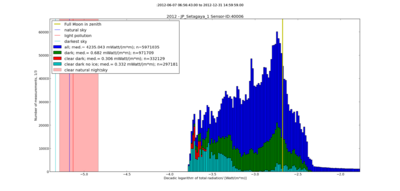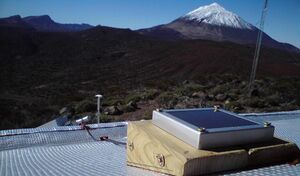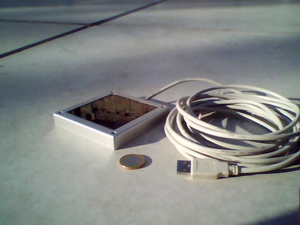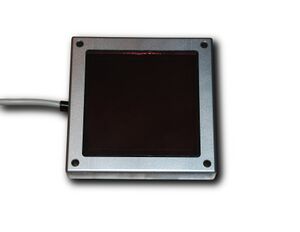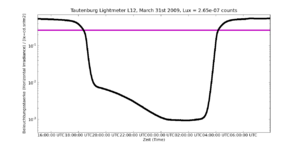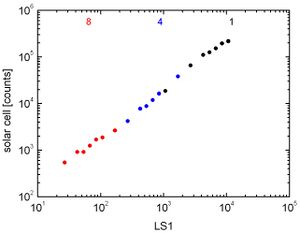Lightmeter
Goal: To continuously measure the state of the world's nightskies with a global network of low-cost lightmeters in the year of astronomy and to start the long-term monitoring of light pollution on Earth.
Description of the Lightmeter
The lightmeter can measure all natural sky-brightnesses. It measures from starshine to sunshine.
Lightmeter performance and calibraton in the Atacama, Müller,Wuchterl and Sarazin 2011, Rev. Mex. Astrom. Astrophys. Vol. 41, pp. 46-49, , preprint(pdf),
Lightmeter technical specifications (new pdf)
Talk on the lightmeter by André Müller at the 2008 European dark sky symposium in Vienna: Low cost luxmeter (pdf,1,7MB)
How to get a Lightmeter
Please contact Verein@Kuffner-Sternwarte.at to borrow or rent a Lightmeter.
Currently Lightmeters are sold out. But you can pre-order the Mark 3 Lightmeter that is currently prepared by writing an E-mail with a statement of interest or pre-order to Verein@Kuffner-Sternwarte.at. We will collect pre-orders and contact the manufacturer.
--GW (talk) 12:15, 1 December 2016 (CET)
Hardware
MarkPro 2.4
- linear domain to higher values to include the Moon and city light-levels in the linear domain
- lower noise electronics than IYA
- solar-cell in Aluminium frame with closed electronics.
- sensor made for outdoor, all-weather use; no protective housing needed
- measures: 15 x 92 x 92 mm
- mass: 370 g (270 g sensor + 100g USB-cable)
- USB-plug (needs weather protection)
- Windows support: [MarkPro 2.4 at k2wlights|http://www.k2wlights.de/indexS.html]
Mark 2.3l
- linear domain to higher values to include the Moon in the linear domain.
- low noise electronics than IYA
- solar-cell in Aluminium frame with closed electronics.
- sensor made for outdoor, all-weather use; no protective housing needed
- measures: 15 x 92 x 92 mm
- mass: 370 g (270 g sensor + 100g USB-cable)
- USB-plug (needs weather protection)
- Linux only - software: see the driver section on this wiki.
Mark 2.3 IYA - International Year of Astronome series
With the extra linear "daylight" Lux-oriented eye. This additional two channel sensor assists in calibrating the non-linear daylight range of the instrument and can be used to directly compare to Lux values as it is manufacturer calibrated and its output can be directly converted to illumination (see the driver section).
- solar-cell in Aluminium frame with closed electronics.
- sensor made for outdoor, all-weather use; no protective housing needed
- measures: 15 x 92 x 92 mm
- mass: 370 g (270 g sensor + 100g USB-cable)
- USB-plug (needs weather protection)
- additional manufaturer-calibrated, TAOS-two-channel daylight Lux-sensor (the small hole in front edge, visible in the image)
Hardware (Mark 2 original series prototype)
- solar-cell in Aluminium frame with closed electronics.
- sensor made for outdoor, all-weather use; no protective housing needed
- measures: 15 x 92 x 92 mm
- mass: 370 g (270 g sensor + 100g USB-cable)
- USB-plug (needs weather protection)
How to install a Lightmeter
To use your lightmeter you have to put it in a place with good visibility of the sky. To extend the USB-cable we recommend a USB-Ethernet-extender. For more see Lightmeter installation.
Software and Installation
You need some software on your computer. You need to install the driver that controlls the instruments and software that stores that data and displays results. See Lightmeter-Driver for information and instructions.
Lightmeter performance
The lightmeter measures fully automatic and up to 20 times per second. Measurmeents are recorded with an adjustable rate of up to once per second and are stored in a .csv or text file with fixes column width that can be easily read with standard spreadsheet software. Nighttime measurements are done in a linear mode that can be easily converted to approximate Lux-values or received energy per unit surface, like [W/m2] that can be readily related to the energy input by the Sun. To directly measure the Sun a non-linear (approximately logarithmic) daylight range operates at brightness levels above the full moon. This allows to compare daylight and nighttime variations. Alltogether the lightmeter measures from a few 100 000 Lux to 100 mikro-Lux,thus covering 11 orders of magnitude, almost as many as the human eye.
For more details see the Lightmeter technical specifications.
Lightmeter locations
Since 2006 the prototype is running in Tautenburg and since March 2009, 30 instruments of the first prototypes (Mark 2.2) are distributed and 20 are running in various places around the world. By December 2009 about 80 Lightmeters of the Year of Astronomy series (Mark 2.3) are distributes and about 40 running. This totals more than 100 Lightmeters with about 60 continuously running around the world. See the Lightmeter List for where they are located and what they measure.
For a view glimpses on the sites please check out the Berlin-Lightmeter (german language): Berlin, Platz der Vereinten Nationen, the Yonago Lightmeter, the Lindenberg station and Cerro Paranal, Chile.
--GuentherWuchterl 13:30, 29. Dez. 2009 (UTC)
Calibration
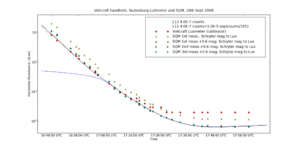
The lightmeter puts out numbers that are basically the number of electrons that are created by the light-particles when they hit the sensor and are then counted by the electronics. To get from that number or counts to a standardised quantity like received Energy per Area (Watt/square meter or in short: W/m2) or Illumination (how much much the Sensor is illuminated) in Lux, or short lx you need a calibration that converts the counts in the standardised measurement quantity in the SI-system. The calibration is usually a factor that has to be multiplied onto the counts that your lightmeter puts out. The standard calibration values to obtain a proxy for the measurement in Lux for the linear night-mode are:
- 2E-6 or 0.000002, for the Mark 2.2 (2008) series,
- 5E-7 for the Mark 2.3 (IYA 2009) series.
--GuentherWuchterl 12:50, 14. Apr. 2010 (UTC) That means e.g. you have to multiply your counts by 0.000002 to obtain the Lux-value. See Lightmeter calibration for more about the calibration of lightmeters and how to get one for your instrument.
Mark 2.3l example
a,b,c,x0,d,f = 1.66e+05, 2.28e-03, 6.76e-07, -2.25e-04, 4.58e-03, 105.4 # LP24 Legstein 10 Hz Tag: 2022/8/4 174645 1 105210 | 0.046 0.000 [0.00049,9.8e+04] 8e-1
Ideas and Requests for Improvements
The lightmeter is a new instrument and we have tried to make measurments easy as possible but only the practical use can show what is needed to get the results in the best way. See Lightmeter improvements for suggestions made and put your own ideas there.
Database for measurements
The Thüringia state observatory and the Kuffner-observatory collect the measurements to create a worldwide database for the state and history of the worlds nightskies. See Lightmeter-database for information of how to upload your data and access that data-collection.
Conversion of light measurements
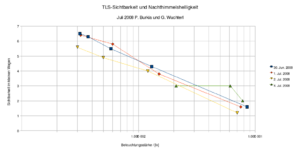
Measurement of the lightmeter can be expressed in various quantities as illumination, the energy flux received by the instrument or the corresponding brightness of the sky or astronomical quantities like the mean brightness per unit area on the sky, for example in magnitudes per square arc-seconds that the Sky Quality Meter puts out.
See Conversion of light measurements for how to obtain one quantity from another one, usually with some assumptions to be made about the state of the night-sky and properties of the contributing light-sources (stars or lamps). Quantities discussed include illuminance, sky-brightness, visual limiting magnitude. Presently the discussion is mostly in German.
Properties of the light sensor
The lightmeter uses a commercial solar cell to detect and measure the light.
The sensitivity of the lightmeter is such that all natural sky-light levels can be measured That includes day and night. Thus the lightmeter can measure the Sun as well as the light emitted from very dark pristine skies in remote locations.
The lightmeter is linear from about the brightness of the full moon (about 0.3 Lux) down to the typical 0.002 Lux of dark skies and lower.
The lowest detectable signal is estimated to be the light of a single bright
star as Sirus.
The measurement range above the full moon has been added to compare the daylight variations to the nighttime variations. This part is experimental and non-linear. That means twice the counts do not correspond to twice the light. These measurments have to be processed to give physical quantities correcly.
Basically the sensor records all wavelength that the eye can see and acts light an ideal detector that is sensitive to all directions: that means if you tilt it the measurements decrease as the surface of the lightmeter projection onto the plane perpendicular to the direction from which the light is shining.
For details on angular and spectral sensitivity as well as the linearity of the solar cell see Lightmeter - instrument properties
Note on the naming
The term lightmeter is more accurate than Luxmeter for the sensor used. The CIE-definition of Lux requires a narrow passband whereas the lightmeter measures over a broad range of colours including photopic, scotopic and metabolic bands. The latter broad band use is more appropriate for astronomical and enviromental purposes. For most nightsky-measurements the quantitative difference is expected to be small and the use of Lux is of advantage for comparison purposes. See What is Light Pollution? by Jan Hollan for a discussion of light-pollution definiton and measures.
Echo
http://www.scienceblogs.de/astrodicticum-simplex/2009/04/lichtverschmutzung-selber-messen.php
http://www.scienceblogs.de/frischer-wind/2009/09/dielichtsmogsensoren-sind-da.php
Current Developments and Articles
Nov. 2019: Lightmeter 3 in preparation; --GW (talk) 12:44, 22 November 2019 (CET)
April 17th: New Mark 2.3 Windows-XP Software for hot summer days (removes bug occurring at T > 46.7°C).
March 9th: Lightmeter reaching out for the stars on top of the 30m tower at the ESO-ELT site, Cerro Armazones.
March 6th: Lightmeter performance and calibraton in the Atacama (A. Mülller et al., preprint)
Nov. 21st: Software for the Mark2.3l post IYA lightmeter online at Lightmeter Driver section.
Oct. 26th: Lightmeter 2010: The IYA-Lightmeter will be continued at the 100.- € per piece cost. The manufacturer k2wlights agreed to continue production of the Lightmeter for the linux driver - this is the Mark 2.3l series.
To get a Mark2.3l lightmeter please mail the Lightmeter request forms to lightmeter@astronomy2009.at.
k2wlights provides Windows-support for a newly developed Mark 2.4 pro version that offers an increased linear range up to 5 Lux and is faster to allow the very quick response required e.g. for mapping purposes under streetlights at speeds above 30 km/h. Contact k2wlights for details.
>160 Lightmeters worldwide (Apr 19th, 2011).
June 18th 2010: Public Lightmeter database in collaboration with the German Astrophysical Virtual Obervatory (GAVO):
- Location: http://vo.uni-hd.de/lightweather
- List of stations that are currently connected to the database,
- Sample query - to plot data scroll down and select VOplot as format.
Please upload your data! Instructions: Lightmeter-database.
Talks and articles:
- Keep it deep, G. Wuchterl on Lightmeter and World-heritage status, talk at the CEDIC 2011, March 20th 2011, Ars Electronica Centre, Linz; http://cedic.at/
- Measuring the Night Sky Brightness with the Lightmeter Lightmeter performance and calibraton in the Atacama (A. Mülller et al., preprint), Conference of Astronomical Site Testing Date in Chile, Valparaiso, 1-3 Dec 2010, http://www.dfa.uv.cl/sitetestingdata/
- Monitoring the Sky with the IYA lightmeter network, G. Wuchterl, 10th European Symposium for the Protection of the Night Sky, 2-4 September 2010, Kaposvár, Hungary, http://www.astro-zselic.hu/symposium.html
- Monitoring Night-Sky Brightness with a Lightmeter Network, G. Wuchterl,talk at 2009 European Symposium for the protection of the night skies, Armagh, Nordirland, http://www.lightpollution2009.eu/
- Measuring the Night Sky Brightness with the Lightmeter Müller, A.; Wuchterl, G.; Sarazin, M. (Müller, Wuchterl, Sarazin)
- Measuring night sky brightness: methods and challenges - a comparison on present techniques and concepts. Also at Measuring ... (archive.org)
